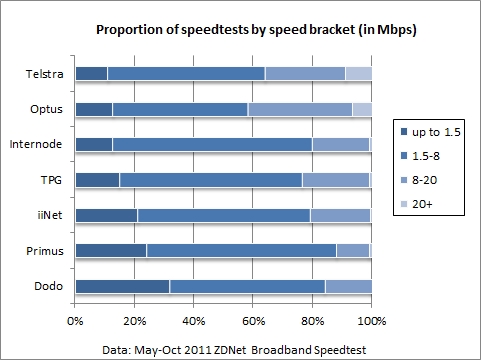Up to speed: look, Ma, no cable

We recently showed how, when it comes to average internet speeds, Telstra and Optus knock the spots off the competition. But this is to be expected; they have HFC networks to crank their averages up. What if we look at the battle below 20Mbps?
Our original analysis, based on almost one million speed tests on ZDNet Australia over the past six months, was certainly influenced by the big two's high number of HFC users: 9 per cent of the Telstra tests and 7 per cent of Optus tests exceeded 20Mbps, compared to just 1 per cent for TPG, iiNet and Internode. At the other end of the scale, Dodo has one third of its users experiencing speeds of less than 1.5Mbps. Lower-cost plans might account for this high ratio, and that will have reflected badly on their average speed overall.

So, for a clearer picture, let's look at the performance within each speed bracket. We have to resort to averages again, but this time it should take us a little nearer to the truth. This chart (below) shows how each provider varies from the average across all tests within each bracket. A score of 100 means that the tests for a particular ISP were in line with the average for that speed range; a score of 111 means 11 per cent faster than the average — which is where iiNet is for all tests below 1.5Mbps. It's an indication that at lower speeds, iiNet is leading the way.
In the 8Mbps to 20Mbps range, Telstra and Optus still rule. But a word of caution: many of these tests will be users on HFC not getting the speed to push them into a higher bracket. If we'd asked what technology was being used, we would have been able to filter out fibre and cable users, and have a more realistic picture of the broader DSL market.
Even with that proviso, whichever way you look at it, Telstra comes out high in all speed ranges. iiNet also does well, rating above average up to 8Mbps. It's not such good news for Optus, though, which ranks below average in the lower-speed categories. Primus and Dodo fall markedly down in the crucial 1.5Mbps to 8Mbps bracket, where more than half of all users are right now. (This isn't an exact science, because averages can be misleading.)
But based on a sample of almost one million tests, it shows enough to suggest that in the sub-8Mbps bracket, Telstra's lead is less significant than highlighted in our earlier analysis, but the company still offers a quality experience. And Optus ... well ... it has a bit of catching up to do.